NIH Research Festival Hosts Postdoc Poster-Palooza
Annual Event Highlights Contributions of IRP Postdoctoral Fellows
At lunchtime last Wednesday, the NIH Clinical Center’s FAES Terrace echoed with the joyful sounds of scientists nourishing their bodies and their brains. While those stopping by the annual NIH Research Festival poster session could be forgiven for making a beeline straight for the food — including the submissions to this year’s Scientific Directors’ baking competition — once their plates were full, they took advantage of the opportunity to satiate their scientific curiosity as well by checking out the dozens of posters on display.
While I would have loved to speak with all 59 IRP postdocs who presented their work at the event, that would have made for a rather long blog post. Instead, read on for a sampling of the work performed by five promising scientists who are refining their craft in IRP labs under the mentorship of some of the world’s most renowned researchers.
Subhash Verma: Exploring Genomic Organization in Infectious Microbes
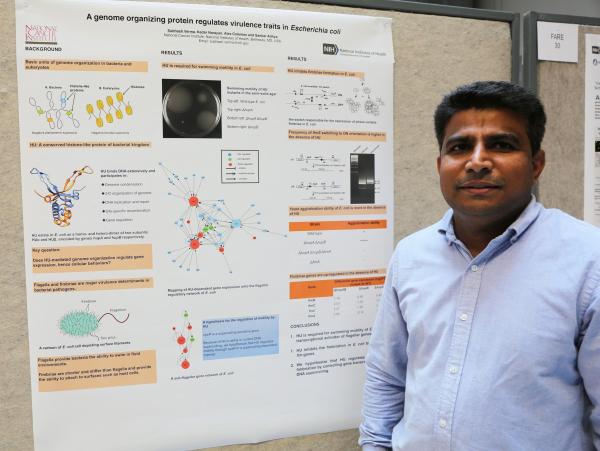
While many scientists study how genes themselves relate to an organism’s ability to infect a host, Subhash Verma is more interested in the molecules that interact with those genes. His research focuses on a protein called HU found in E. colibacteria. HU helps maintain the three-dimensional organization of the E. coligenome, which affects how active various genes are.
Subhash has found that HU plays a critical role in the development of two parts of the E. coli cell that influence how infectious the organism is: its flagellum, a whip-like appendage that helps the bacterium move around inside the body, and the fimbriae, which help E. coli attach to other cells. Learning how molecular factors like HU control such infection-related processes may help scientists develop therapeutic approaches to combat dangerous bacteria.
“I love working at the NIH,” Subhash says. “There’s a lot of intellectual freedom and you get to explore your own path, so there’s more learning. It’s full of resources and people who are open to collaborating. It’s a very open environment.”
Xiuli Dan: Delving Into the Disposal of Cellular Powerhouses
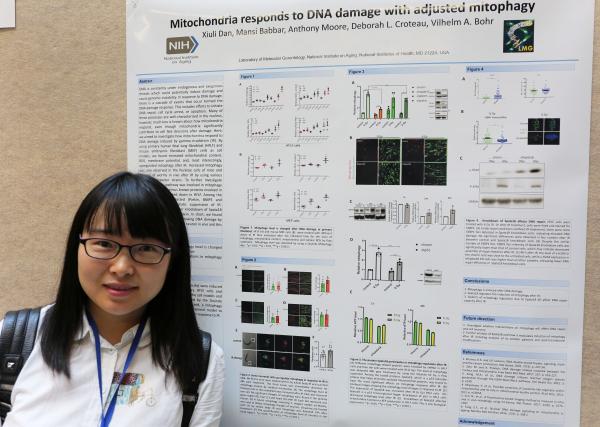
A cell cannot live without the energy produced by its mitochondria, but like a nuclear reactor in the midst of a meltdown, malfunctioning mitochondria can do a lot of damage to their surroundings. Xiuli Dan is investigating a process called ‘mitophagy’ by which cells get rid of dysfunctional mitochondria. Prior research has connected problems with mitophagy to aging-related diseases like Alzheimer’s, as well as cancer.
Xiuli’s experiments with human cells, mice, and the tiny worm-like organism C. elegans have revealed that mitophagy ramps up considerably in certain cell types after they are exposed to DNA-damaging gamma radiation, and that this process relies in part on a protein called Spata18. When a cell has less Spata18, it does not carry out mitophagy as efficiently and also repairs its radiation-ravaged DNA less effectively. Therefore, intervening in cells to boost mitophagy may help them fix DNA damage and remain healthy.
“The NIH has a lot of different resources,” Xiuli says. “We have everything we need: confocal microscopes and animal and C. elegans models. It’s very convenient. It’s a nice experience to work here.”
Emily Speranza: Studying the World’s Deadliest Viruses
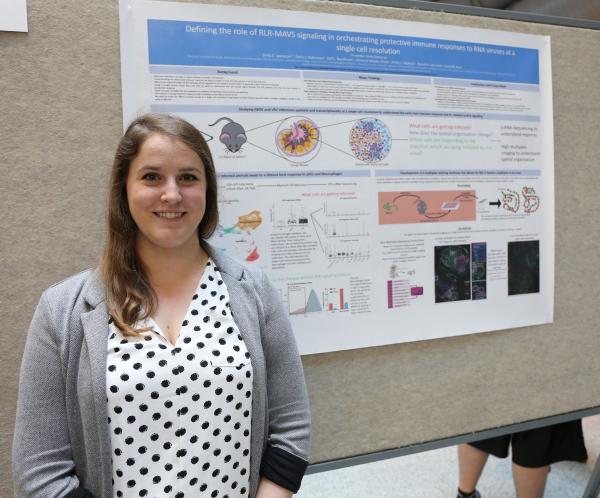
Performing scientific experiments is hard enough without having to adhere to the strict safety procedures required when working with incredibly dangerous viruses like Ebola and Marburg virus. Nevertheless, that is exactly what Emily Speranza did in the NIH’s Biosafety Level 4 (BSL-4) lab facility at Rocky Mountain Labs (RML) in Hamilton, Montana.
Emily’s interest in highly infectious diseases began early in life when she read about the 1995 Ebola outbreak in Kitwit in the Democratic Republic of the Congo (then called Zaire).
“I thought it was fascinating that something so small with seven genes can just rip through a population like that,” she says. “I’ve wanted to study this for a very long time.”
Back at RML, and now on the main NIH campus in Bethesda, Maryland, Emily designs laboratory techniques for studying highly infectious viruses in the BSL-4 environment. In addition, she uses the methods she creates to study how those viruses interact with their hosts during the early stages of infection, which could shed light on why some people survive them and others do not. For example, she has discovered that a particular type of immune cell called plasmacytoid dendritic cells (pDCs) that are found in the body’s lymph nodes appear to play an important role in providing protection against the Ebola virus.
“Someone once described the NIH to me as ‘Disneyland for nerds’ because there’s not the same pressures that you have in other research settings like universities,” Emily says. “People really are just here to do the science. They love the science in the most pure way I’ve ever seen.”
Chitrangda Srivastava: Fighting Fat Formation at the Molecular Level
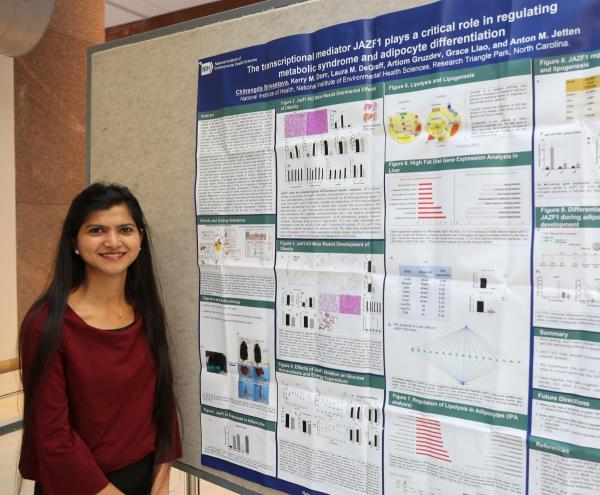
Chitrangda Srivastava’s motivation to study obesity stems from a love of good food and a desire to “give the public a way to eat what they want to eat” without gaining unhealthy amounts of weight. Right now, a combination of excessive food consumption and low levels of physical activity has made more than a third of Americans obese, which can lead to health problems like type 2 diabetes and cardiovascular disease. However, a gene called JAZF1 appears to be a promising target for potentially preventing obesity.
Chitrangda’s research has shown that the JAZF1 gene is active in fat cells and that mice that lack the gene do not become obese after consuming a high-fat diet for two weeks, whereas their genetically typical counterparts do. The mice without the gene also showed better blood sugar control while on the high-fat diet than the animals with intact JAZF1 genes, suggesting that tamping down how active JAZF1is or inhibiting the molecule it produces might help combat weight gain and its related health problems in humans.
“Working at NIH is tremendously awesome,” Chitrangda’s says. “The core facilities here are so supportive, and the independence of doing research is really appreciable. I feel like I can have my own hypotheses and implement them during my experiments, but there are also people who help me. My supervisor always gives good advice when I’m stuck in troubleshooting my experiments, and I can also ask the core facilities for help. There’s a lot of assistance available for me.”
Jeremiah Bertz: Examining Employment’s Effects on Addiction Recovery
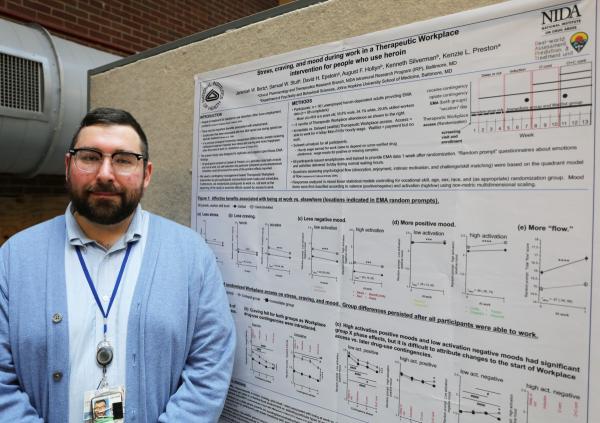
Every day, more than 130 Americans die from an opioid-related drug overdose. With the U.S. in the midst of an 'opioid crisis,' improving treatment for individuals with opioid use disorder has become an urgent priority. Intriguingly, past research has suggested that having a job can improve the effectiveness of treatment for people recovering from opioid addiction, and Jeremiah Bertz aims to find out why.
The individuals in Jeremiah’s study participated in an employment program in which submitting samples for drug tests (and passing the tests) resulted in increased hourly pay for their work. A random selection of the participants started working at the start of the study, while others had to wait several weeks to begin. Meanwhile, all of them were given a smartphone with an app loaded onto it that prompted them to report information about their emotions and activities at random times during the day, some of which fell during work hours and some of which did not.
After crunching the numbers, Jeremiah found that when the participants were at work, they reported less stress, less craving for heroin and cocaine, more positive mood, and more psychological ‘flow’ — deep absorption and engagement in what they were doing at that moment — compared to when they were not at work. And while the participants who waited to begin the work program reported higher stress throughout the study, the work program appeared to decrease craving for illicit drugs in both those who began working immediately and those who had to wait. These sorts of results could help explain why employment is so beneficial to the process of recovery from opioid addiction.
“My mentors have done a lot of really pioneering work with these kinds of field-based measures that collect data from people in treatment for opioid use disorders outside of the clinic while they’re living their daily lives, which I think is really important,” Jeremiah says. “That’s kind of where the rubber meets the road. And I think, at the time I joined the lab, we were one of the few places in the world doing that.”
“NIH has a great combination of people who are doing really cutting-edge, high-risk, high-reward research — doing research that other people aren’t doing — but are also nice, kind, healthy people,” he adds. “Being able to do really good science in a good interpersonal environment is great. What more could you ask for?”
The training that postdocs like Emily, Subhash, Xiuli, Chitrangda, and Jeremiah receive at the NIH plays a vital role in launching them into the next stage of their careers. Whether they remain at the NIH, spread to the nation’s universities, or take their talents to industry, the talented postdocs pursuing their scientific passions in the IRP will spend their careers making remarkable contributions to science that help save and improve millions of lives.
Subscribe to our weekly newsletter to stay up-to-date on the latest breakthroughs in the NIH Intramural Research Program.
Related Blog Posts
This page was last updated on Monday, January 29, 2024
